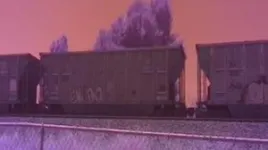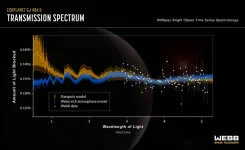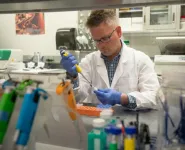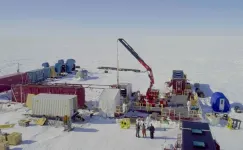(Press-News.org) Coal trains and terminal operations add a significant amount of fine particulate matter (PM2.5) pollution to urban areas, more so than other freight or passenger trains, according to a study conducted in Richmond, California, by the University of California, Davis.
The paper, published in the journal Air Quality, Atmosphere & Health, is the first study of coal train particulate pollution in a U.S. urban area. It’s also the first to use artificial intelligence technologies to verify that the source of air pollution detected comes from coal.
It found that passing trains carrying coal add on average 8 micrograms per cubic meter of air (ug/m3) to ambient PM2.5 pollution. That is 2 to 3 ug/m3 more than freight trains contribute. Even empty coal cars add about 2 ug/m3 to the air due to traces of coal dust. Under certain wind conditions, these concentrations reached 25 ug/m3.
Environmental justice concerns
The authors released a full report this week to the California Air Resources Board with additional measurements of coal and petroleum coke (a byproduct of oil refining). It demonstrated that the storage and handling of these materials at shipping terminals and train holding yards also emit PM2.5, and that this air pollution reaches residential communities.
That report further describes the health and environmental justice implications of coal-related pollution for residents in Richmond and in nearby Oakland, where a coal terminal proposal is currently under discussion.
oal trains and terminal operations add a significant amount of fine particulate matter (PM2.5) pollution to urban areas, more so than other freight or passenger trains, according to a study conducted in Richmond, California, by the University of California, Davis.
The paper, published in the journal Air Quality, Atmosphere & Health, is the first study of coal train particulate pollution in a U.S. urban area. It’s also the first to use artificial intelligence technologies to verify that the source of air pollution detected comes from coal.
It found that passing trains carrying coal add on average 8 micrograms per cubic meter of air (ug/m3) to ambient PM2.5 pollution. That is 2 to 3 ug/m3 more than freight trains contribute. Even empty coal cars add about 2 ug/m3 to the air due to traces of coal dust. Under certain wind conditions, these concentrations reached 25 ug/m3.
Environmental justice concerns
The authors released a full report this week to the California Air Resources Board with additional measurements of coal and petroleum coke (a byproduct of oil refining). It demonstrated that the storage and handling of these materials at shipping terminals and train holding yards also emit PM2.5, and that this air pollution reaches residential communities.
That report further describes the health and environmental justice implications of coal-related pollution for residents in Richmond and in nearby Oakland, where a coal terminal proposal is currently under discussion.
Between May 2022 and October 2022, the monitor was placed along train tracks in Richmond, a city in the San Francisco Bay Area with a racially diverse population of about 115,000 people and high rates of asthma and heart disease. Other monitoring took place over the past two years.
The authors found that coal transport, storage and handling significantly increase community exposure to ambient PM2.5.
“The sheer scope of the project inspired us to experiment with computer-learning,” Spada said. “We developed a cutting-edge system, and it really paid off. Several thousand trains were observed in this study and were classified with a high degree of confidence. This included passenger, freight, and unloaded and full coal cars.”
The researchers said an unforeseen benefit was that this technology can be applied to help pinpoint the source and level of pollution of many air pollution concerns, from refinery flaring and construction dust to unloading and loading at shipyards.
No safe level
The World Health Organization and U.S. Environmental Protection Agency indicate there is no known safe level of PM2.5. A recent study of the Global Burden of Disease estimates that fine particulate matter pollution contributes to 6.7 million deaths per year globally.
“Adverse effects are borne disproportionately by the most vulnerable, including infants, children and the elderly, people of color, those with low incomes and those with underlying health conditions,” the authors wrote.
The scientists did not measure ultrafine or coarse particles (PM10), which are also generated with PM2.5. This indicates that the study likely underestimates the actual health risks posed by passing coal trains.
The study was funded by the California Air Resources Board Community Air Monitoring Grant Program.
END
Coal trains increase air pollution in San Francisco bay area
Study quantifies pollution, with health and environmental justice implications for Richmond and Oakland
2023-05-01
ELSE PRESS RELEASES FROM THIS DATE:
Silver nanoparticles spark key advance in thermoelectricity for power generation
2023-05-01
HOUSTON – Several high-performance thermoelectric materials have been discovered over the past two decades, but without efficient devices to convert the energy they produce into emission-free power, their promise has been unfulfilled. Now an international team of scientists led by a University of Houston physicist and several of his former students has reported a new approach to constructing the thermoelectric modules, using silver nanoparticles to connect the modules’ electrode and metallization layers.
The ...
A new method to test cancer drug toxicity
2023-05-01
For people with cancer, chemotherapy saves lives, but for some patients, the treatment comes with a side effect—heart damage. Screening cancer drugs for cardiotoxicity has been an ongoing challenge as heart cells don’t naturally grow in a dish, requiring researchers to do this critical testing using cardiac tissue from rodent models. A new study from researchers at Cummings School of Veterinary Medicine at Tufts University and Tufts Medical Center reports that heart tissue obtained through organ donations from dogs dying of other causes are a promising platform for testing cancer drug toxicity, offering scientists a new alternative.
The ...
Webb finds water vapor, but from a rocky planet or its star?
2023-05-01
The most common stars in the universe are red dwarf stars, which means that rocky exoplanets are most likely to be found orbiting such a star. Red dwarf stars are cool, so a planet has to hug it in a tight orbit to stay warm enough to potentially host liquid water (meaning it lies in the habitable zone). Such stars are also active, particularly when they are young, releasing ultraviolet and X-ray radiation that could destroy planetary atmospheres. As a result, one important open question in astronomy is whether a rocky planet could maintain, or reestablish, an atmosphere in such a harsh environment.
To help answer that question, astronomers ...
Cannabis knocks down pain, improves sleep and lifts brain fog in cancer patients
2023-05-01
Cancer patients who use cannabis to address their symptoms have less pain and sleep better, according to new University of Colorado Boulder research. But they also experience another, unexpected, benefit: After a few weeks of sustained use, they seem to think more clearly.
“When you’re in a lot of pain, it’s hard to think,” said senior author Angela Bryan, a professor of psychology and neuroscience at CU Boulder and a cancer survivor. “We found that when patients’ pain levels came down after using cannabis for a while, their cognition got better.”
The small but groundbreaking study, published ...
Jutras Lab awarded $1.2 million to create rapid and accurate Lyme disease testing
2023-05-01
A rapid, at-home test that can diagnose acute Lyme disease? That is the goal for researcher Brandon Jutras and his team at Virginia Tech’s Fralin Life Sciences Institute.
Through the support of a recent $1.2 million multiyear therapeutic/diagnostic research tick-borne disease grant awarded by the Department of Defense, Jutras' vision may one day become a reality. This research award aims to improve patient care and quality of life for military service members, veterans, and their beneficiaries as well as the American public living with Lyme disease and other tick-borne diseases.
“Current ...
Study: Police murder of George Floyd associated with short-term spike in firearm assaults on US police officers
2023-05-01
The police murder of George Floyd sparked nationwide protests in the summer of 2020 and revived claims that public outcry over such high-profile police killings perpetuates a violent “war on cops.” In a new study, researchers assessed if and how patterns of firearm assault on police officers in the United States were influenced by the police murder of Floyd. The study found that Floyd’s murder was associated with a three-week spike in firearm assaults on police, after which the trend in such assaults dropped to levels slightly above those predicted by pre-Floyd ...
West Antarctic Ice Sheet retreated far inland, re-advanced since last Ice Age
2023-05-01
WASHINGTON — The West Antarctic Ice Sheet is melting rapidly, raising concerns it could cross a tipping point of irreversible retreat in the next few decades if global temperatures rise 1.5 to 2.0 degrees Celsius (2.7 to 3.8 degrees Fahrenheit) above preindustrial levels. New research finds that 6,000 years ago, the grounded edge of the ice sheet may have been as far as 250 kilometers (160 miles) inland from its current location, suggesting the ice retreated deep into the continent after the end of the last ice age and re-advanced before modern retreat began.
“In the last few thousand years before we started watching, ...
Young women more likely to return to the hospital in year following heart attack
2023-05-01
Young women who experience a heart attack have more adverse outcomes and are more likely to end up back in the hospital compared to men of a similar age in the year following discharge. According to a study published in the Journal of the American College of Cardiology, second heart attack and chest pain due to the heart are the most common causes of rehospitalization, but non-cardiac hospitalizations showed the most significant disparity.
“This all begins with public awareness towards preventing heart attacks and screening ...
Risk of rehospitalization in younger women after heart attack nearly double that of men
2023-05-01
Women aged 55 years and younger have nearly double the risk of rehospitalization in the year immediately after a heart attack compared to men of similar age, according to a study supported by the National Institutes of Health. Higher rates of risk factors such as obesity, heart failure, and depression among women most likely contributed to the disparity.
The findings suggest a need for closer health monitoring of the approximately 40,000 American women aged 18 to 55 years who have heart attacks each year following hospital discharge, and a better understanding of the reasons behind ...
Nuances of the forest-water connection
2023-05-01
The infrastructure that brings drinking water to homes is an investment. For millions of people, forests are part of the system behind their faucets. Over the coming decades, many forested watersheds could be lost to development, lowering water quality and raising water treatment costs, according to a new study published in the journal Science of the Total Environment.
The research team focused on the forest-water connection in the southern U.S., a complex, heterogeneous region and, unfortunately, an ideal place for studying forest loss and worsening water quality. ...
LAST 30 PRESS RELEASES:
The Ceramic Society of Japan’s Oxoate Ceramics Research Association launches new international book project
Heart-brain connection: international study reveals the role of the vagus nerve in keeping the heart young
Researchers identify Rb1 as a predictive biomarker for a new therapeutic strategy in some breast cancers
Survey reveals ethical gaps slowing AI adoption in pediatric surgery
Stimulant ADHD medications work differently than thought
AI overestimates how smart people are, according to HSE economists
HSE researchers create genome-wide map of quadruplexes
Scientists boost cell "powerhouses" to burn more calories
Automatic label checking: The missing step in making reliable medical AI
Low daily alcohol intake linked to 50% heightened mouth cancer risk in India
American Meteorological Society announces Rick Spinrad as 2026 President-Elect
Biomass-based carbon capture spotlighted in newly released global climate webinar recording
Illuminating invisible nano pollutants: advanced bioimaging tracks the full journey of emerging nanoscale contaminants in living systems
How does age affect recovery from spinal cord injury?
Novel AI tool offers prognosis for patients with head and neck cancer
Fathers’ microplastic exposure tied to their children’s metabolic problems
Research validates laboratory model for studying high-grade serous ovarian cancer
SIR 2026 delivers transformative breakthroughs in minimally invasive medicine to improve patient care
Stem Cell Reports most downloaded papers of 2025 highlight the breadth and impact of stem cell research
Oxford-led study estimates NHS spends around 3% of its primary and secondary care budget on the health impacts of heat and cold in England
A researcher’s long quest leads to a smart composite breakthrough
Urban wild bees act as “microbial sensors” of city health.
New study finds where you live affects recovery after a hip fracture
Forecasting the impact of fully automated vehicle adoption on US road traffic injuries
Alcohol-related hospitalizations from 2016 to 2022
Semaglutide and hospitalizations in patients with obesity and established cardiovascular disease
Researchers ‘listen in’ to embryo-mother interactions during implantation using a culture system replicating the womb lining
How changing your diet could help save the world
How to make AI truly scalable and reliable for real-time traffic assignment?
Beyond fragmented markets: A new framework for efficient and stable ride-pooling
[Press-News.org] Coal trains increase air pollution in San Francisco bay areaStudy quantifies pollution, with health and environmental justice implications for Richmond and Oakland







